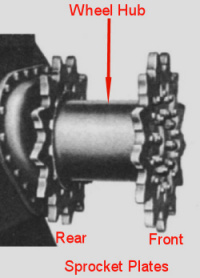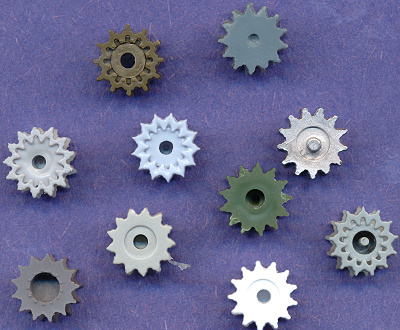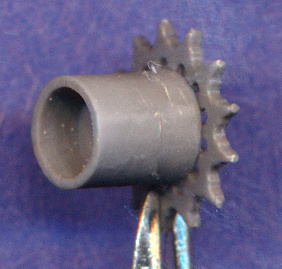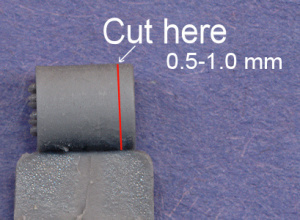| Caveat! These numbers are based on my
measurements and test fitting without glue. Please keep
in mind that I have not actually built all of these
combinations, so when cutting plastic, you should do a
little at a time and constantly test fit, so as to not
take off too much. If anyone has undertaken any of these
surgeries and came to different conclusions than what I
have listed here, please let me know.
Notes:
The Dragon tracks do not work on several of
the available sprocket wheels because the pitch is too
big on the track shoes (2.5 mm - should be 2.1 mm),
resulting in each track run also having too few track
links (71 links versus the correct 79).
The Eduard/Extratech tracks are hard plastic link and
length. On the individual links, the track teeth are
molded onto the end connectors (just as they should be),
but on some sprockets, these teeth get in the way of the
sprocket plates, and may need to be removed.
The Italeri/ESCI tracks have very short end
connectors, and this poses a problem when fitting to the
sprockets. If the track shoes fit between the sprocket
plates, the end connectors won't grab the sprocket teeth
properly. But if the end connectors fit into the sprocket
teeth, the track shoes are then too wide. Notice that the
lack of one sprocket tooth does not necessarily hinder
the fit of many of the available tracks.
The Revell tracks are hard plastic link and
length. The individual links are slightly narrower than
the links that are part of the longer track runs. The end
connectors are also slightly larger on the individual
links, and in many cases need to be cut down some to fit
into other manufacturers' sprockets.
The hard plastic link
and length tracks from UM don't fit correctly on any sprocket
wheel, even UM's own piece. The track shoes are much too
narrow, leaving the end connectors (and the teeth molded
on to them) too long. Even if the sprocket teeth fit
between the track's end connectors, as they do on UM's
sprocket wheels, there are large gaps between the inside
of the sprocket plates and the edges of the track shoes.
I really can see no way that these tracks can be used by
any kit. Perhaps they would be good for welding onto the
kit hulls as add-on armor?
Curiously, the tracks
from OKB
Grigorov vary in
width between track sets. So modifications to each of the
above sprocket wheels, including OKB's own sprockets,
will have to vary, based on which OKB tracks are being
used. The first table below shows the hub modifications
(if any) needed to make these tracks fit the OKB sprocket
wheels.
| Track Name |
Track Width |
Necessary modifications
to OKB hubs: |
| WE210 |
I cannot find my set of tracks
(!). |
Probably need to be shortened by
1.5 mm, but cannot confirm until I find my
tracks. |
| T54E1 |
6.3mm |
Tracks are just a little bit
loose, but no adjustment is necessary. |
| T54E2 |
6.0mm |
Hub should be shortened by 1.0 mm. |
| T62 |
6.4mm |
No adjustment necessary. |
| T48 |
6.4mm |
No adjustment necessary. |
| T49 |
6.1mm |
Hub should be shortened by 1.0 mm. |
| T51 |
6.5mm |
Perfect fit. |
| T56 |
6.5mm |
Perfect fit. |
| T74 |
6.3mm |
Tracks are just a little bit
loose, but no adjustment is necessary. |
This
table shows the hub modifications (if any) needed to make
these tracks fit to sprocket wheels of other
manufacturers. The question marks on the ESCI and Revell
wheels indicate the possibility that this particular
track/sprocket wheel combination may not work, due to the
end connectors not fitting between the sprocket teeth,
due to the track shoe pitch being different than the gap
between the teeth.
| Sprocket |
OKB
Track |
| WE210 |
T48 |
T49 |
T51 |
T54E1 |
T54E2 |
T56 |
T62 |
T74 |
| Dragon |
? |
+0.5 |
0 |
+0.5 |
+0.2 |
0 |
+0.5 |
+0.5 |
+0.2 |
| Eduard/ExtraTech |
? |
+1.5 |
+1.0 |
+1.5 |
+1.5 |
+1.0 |
+1.5 |
+1.5 |
+1.5 |
| Heller |
? |
+1.0 |
+0.5 |
+1.0 |
+0.5 |
+0.5 |
+1.0 |
+1.0 |
+0.5 |
| Italeri/ESCI |
? |
+1.5? |
+1.0? |
+1.5? |
+1.5? |
+1.0? |
+1.5? |
+1.5? |
+1.5? |
| Mirage |
? |
+1.0 |
+0.5 |
+1.0 |
+0.5 |
+0.5 |
+1.0 |
+1.0 |
+0.5 |
| MR Models |
? |
+1.0 |
+0.5 |
+1.0 |
+0.5 |
+0.5 |
+1.0 |
+1.0 |
+0.5 |
| Revell |
? |
+1.0? |
+0.5? |
+1.0? |
+0.5? |
+0.5? |
+1.0? |
+1.0? |
+0.5? |
| Trumpeter |
? |
+1.5 |
+1.0 |
+1.5 |
+1.5 |
+1.0 |
+1.5 |
+1.5 |
+1.5 |
| UniModel |
? |
+1.0 |
+0.5 |
+1.0 |
+0.5 |
+0.5 |
+1.0 |
+1.0 |
+0.5 |
|



